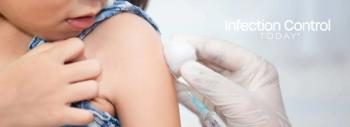
Environmental Services Workers Need to be Certified
Darrel Hicks: “EVS teams work around professionals who are certified—whether it’s respiratory therapists, physical therapists, the RNs, the doctors—and I think if we ever hoped to elevate their status that we need to certify environmental services workers to a certain level of knowledge before they even start cleaning patient rooms.”
COVID-19 highlighted the
Infection Control Today®: What were some of the changes caused by COVID-19 when it comes to procedures for safe and clean disinfection in health care that you think will last after the pandemic?
Darrel Hicks: Well, it changed a lot of things. It was a time of shortages, with the supply chain shortages of disinfectants. Certainly shortages of personal protective equipment. It was a very difficult time for the first few months. It seemed to level out after that. But because there wasn’t PPE for those who weren’t doing direct patient care, they’re trying to reserve what they have. They’re burning through isolation gowns and masks so quickly that the environmental services team was in many cases not involved with cleaning that patient’s room unless it was a
and around the patient bed. I call that patient bed the hot zone in the patient’s room. It’s more contaminated than the restroom is. And so that patient bed and the 36 inches around it… Just think about the shedding of these organisms. That was the hot zone. And in many cases the nurses were expected to maintain that environment. And only on discharge or terminal cleaning was EVS [environmental services] brought into the picture. So, that was different at first. And I think a lot of that leveled off later on. I think it really brought to fore the essential workers that EVS are in health care. What I have said for many years is that when this pandemic would come, that we need to have people who are environmental services workers who are certified to some level of knowledge about the transmission of disease, and their role in breaking that chain of infection. Too often, we just told them you use the pink stuff on this and here’s the color-coded microfiber wipes and here’s how you do it. And it was the how-tos without the why behind it. I think that we still need to certify that these workers that now we’re short of…. It used to be that they would come to work from a quick food service drive-through. And now they’re going to be cleaning patient rooms or possibly even the operating room this week when they were stuffing hamburgers into a bag last week. What has prepared them to protect the patients and the staff if we don’t have some level of certification for those workers?
ICT®: When you say certification for EVS, what do you mean by that?
Hicks: I believe that they should be certified to a certain level of knowledge. In order to be certified, they need to be well trained. They need to be equipped with the necessary tools and equipment to do the job. They need to be allotted the right amount of time to do the task. And you can’t rush the process. They need to be…. We need to be measuring clean in those areas. So that we know that the products and the process and the person doing the job are validated. We audit the cleanliness of the area. And finally, that they’re being educated about the prevention and transmission of disease. That we are not just cleaning toilets and mopping floors. We have to be infection prevention on that frontline. Because it’s so important that we break that chain of infection. And you know that terminal cleaning is probably the one opportunity, but yet we find that wherever we scientifically measure the room after it’s been terminally cleaned, in many cases, fewer than 50% of those surfaces that are points of transmission were properly cleaned and disinfected. We have a long way to go to get to the point where we’re confident that [pathogens] don’t get passed from the previous patient to the next patient. But beyond COVID-19, we know that just with Clostridioides difficile…. That if we don’t break that chain of infection with that terminal clean that the next patients are put in much greater risk, sometimes 100% more risk of getting C diff, if we don’t do a proper job of removing the spores and then disinfecting with the right disinfectants. And during COVID-19 I think we were so focused on getting products that were on EPA’s [Environmental Protection Agency’s]
ICT®: When you talk about certifying EDS teams, are you saying that each hospital system should basically educate them better? Are you thinking about some kind of national certification process?
Hicks: I think that we first of all need to agree on what that education should consist of. There are some good education programs out there, whether APIC [Association for Professionals in Infection Control and Epidemiology] put them out. But even when I see CDC’s…. Wherever I watched their information videos on COVID-19 cleaning and disinfection, I find that…. First of all, the terminology. It’s important that we agree on the terminology. And that we first get rid of the term clean or cleaning, because it means different things to different people. And ultimately, the person that’s doing the cleaning and disinfection needs to understand that it’s two separate operations. And too often, we interchange those terms. We have to come to an agreement—whatever certification program there is—about terminology. And we have to agree that these terms have gotten to be used in the education of the frontline workers doing that task. I think that we need to bring the stakeholders to the table. And I think that APIC, and
ICT®: Do you think infection preventionists should monitor EVS departments?
Hicks: I do. And I think that [IPs should audit] that surfaces are indeed safe for patients. And I’m not going to say disinfected, because disinfection takes a great deal more effort. And to get surfaces to that level, then it’s going to take more time in that room to do that. Right now, the EVS person on a regular daily cleaning, if it’s a semi-private room and a restroom, they’re allotted 12 to 15 minutes in that room to do the daily cleaning and disinfecting. And on a terminal cleaning, it’s maybe 30 minutes, but that 30 minutes includes stripping the bed, washing the bed, cleaning all the surfaces in the room and making the bed. Depending on the length of stay of that patient—some of these patients during COVID-19 were in there for 30 to 60 to 180 days. And so I guarantee that environment in that patient room is going to take longer than 30 minutes to do a terminal cleaning. But I think that those two groups, the AHE and APIC, they’re the stakeholders. I believe that infection preventionists do need to be involved in auditing of the rooms. And that there is a way of tracking all of that. So, you know,
This interview has been edited for clarity and length.
Newsletter
Stay prepared and protected with Infection Control Today's newsletter, delivering essential updates, best practices, and expert insights for infection preventionists.






